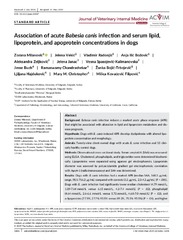Приказ основних података о документу
Association of acute Babesia canis infection and serum lipid, lipoprotein, and apoprotein concentrations in dogs
| dc.creator | Milanović, Zorana | |
| dc.creator | Vekić, Jelena | |
| dc.creator | Radonjić, Vladimir | |
| dc.creator | Božović-Ilić, Anja | |
| dc.creator | Zeljković, Aleksandra | |
| dc.creator | Janac, Jelena | |
| dc.creator | Spasojevic-Kalimanovska, Vesna | |
| dc.creator | Buch, Jesse | |
| dc.creator | Chandrashekar, Ramaswamy | |
| dc.creator | Bojic-Trbojević, Zanka | |
| dc.creator | Hajduković, Ljiljana | |
| dc.creator | Christopher, Mary M. | |
| dc.creator | Kovačević-Filipović, Milica | |
| dc.date.accessioned | 2020-06-03T14:36:17Z | |
| dc.date.available | 2020-06-03T14:36:17Z | |
| dc.date.issued | 2019 | |
| dc.identifier.issn | 0891-6640 | |
| dc.identifier.uri | https://vet-erinar.vet.bg.ac.rs/handle/123456789/1778 | |
| dc.description.abstract | Background Babesia canis infection induces a marked acute phase response (APR) that might be associated with alteration in lipid and lipoprotein metabolism and disease prognosis. Hypothesis Dogs with B. canis-induced APR develop dyslipidemia with altered lipoprotein concentration and morphology. Animals Twenty-nine client-owned dogs with acute B. canis infection and 10 clinically healthy control dogs. Methods Observational cross-sectional study. Serum amyloid A (SAA) was measured using ELISA. Cholesterol, phospholipids, and triglycerides were determined biochemically. Lipoproteins were separated using agarose gel electrophoresis. Lipoprotein diameter was assessed by polyacrylamide gradient gel electrophoresis; correlation with ApoA-1 (radioimmunoassay) and SAA was determined. Results Dogs with B. canis infection had a marked APR (median SAA, 168.3 mu g/mL; range, 98.1-716.2 mu g/mL) compared with controls (3.2 mu g/mL, 2.0-4.2 mu g/mL) (P < .001). Dogs with B. canis infection had significantly lower median cholesterol (4.79 mmol/L, 1.89-7.64 mmol/L versus 6.15 mmol/L, 4.2-7.4 mmol/L) (P = .02), phospholipid (4.64 mmol/L, 2.6-6.6 mmol/L versus 5.72 mmol/L, 4.68-7.0 mmol/L) (P = .02), and alpha-lipoproteins (77.5%, 27.7%-93.5% versus 89.2%, 75.1%-93.5%) (P = .04), and higher ApoA-1 (1.36 U, 0.8-2.56 U versus 0.95 U, 0.73-1.54 U) concentrations (P = .02). Serum amyloid A correlated with high-density lipoproteins (HDLs) diameter (rho = .43; P = .03) and ApoA-1 (rho = .63, P < .001). Conclusions and Clinical Importance Major changes associated with B. canis-induced APR in dogs are related to concentration, composition, and morphology of HDL particles pointing to an altered reverse cholesterol transport. Parallel ApoA-1 and SAA concentration increase is a unique still unexplained pathophysiological finding. | en |
| dc.publisher | Wiley, Hoboken | |
| dc.relation | IDEXX Laboratories, Inc., Westbrook, Maine, USA | |
| dc.relation | LKB Vertriebs Ges.m.b.h., Belgrade | |
| dc.relation | info:eu-repo/grantAgreement/MESTD/Basic Research (BR or ON)/175035/RS// | |
| dc.relation | info:eu-repo/grantAgreement/MESTD/Basic Research (BR or ON)/175061/RS// | |
| dc.rights | openAccess | |
| dc.rights.uri | https://creativecommons.org/licenses/by-nc/4.0/ | |
| dc.source | Journal of Veterinary Internal Medicine | |
| dc.subject | acute phase response | en |
| dc.subject | apolipoprotein A-1 | en |
| dc.subject | high-density lipoprotein | en |
| dc.subject | lipoprotein diameter | en |
| dc.subject | serum amyloid A | en |
| dc.title | Association of acute Babesia canis infection and serum lipid, lipoprotein, and apoprotein concentrations in dogs | en |
| dc.type | article | |
| dc.rights.license | BY-NC | |
| dcterms.abstract | Спасојевиц-Калимановска, Весна; Милановић, Зорана; Цхандрасхекар, Рамасwамy; Бојиц-Трбојевић, Занка; Цхристопхер, Марy М.; Хајдуковић, Љиљана; Радоњић, Владимир; Божовић-Илић, Aња; Зељковић, Aлександра; Јанац, Јелена; Буцх, Јессе; Векић, Јелена; Ковачевић-Филиповић, Милица; | |
| dc.citation.volume | 33 | |
| dc.citation.issue | 4 | |
| dc.citation.spage | 1686 | |
| dc.citation.epage | 1694 | |
| dc.citation.other | 33(4): 1686-1694 | |
| dc.citation.rank | aM21 | |
| dc.identifier.wos | 000481436400016 | |
| dc.identifier.doi | 10.1111/jvim.15537 | |
| dc.identifier.pmid | 31175698 | |
| dc.identifier.scopus | 2-s2.0-85067417594 | |
| dc.identifier.fulltext | https://vet-erinar.vet.bg.ac.rs/bitstream/id/740/1777.pdf | |
| dc.type.version | publishedVersion |

